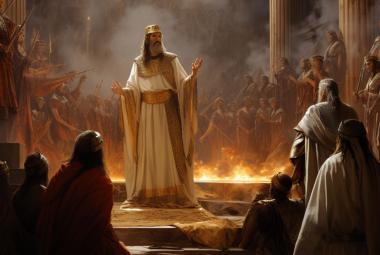Ezekiel was one of the most fascinating and mystical prophets of the Old Testament. He was held captive with King Jehoiachin in the second of three deportations under Nebuchadnezzar, years before Jerusalem was overthrown. Daniel, who had been in Babylon years before Ezekiel arrived, is mentioned three times.
Ezekiel used symbols and allegory more than other prophets. He had a remarkable vision of God’s Throne in Chapter 1, and this vision was referenced throughout the book. God intended his very life to be a sign to Israel; Ezekiel therefore engages in some strange behavior: he shut himself up in his home, bound himself, and was struck dumb. He was to lie on his right and his left sides for a total of 430 days, he ate bread that was prepared in an unclean manner, and he shaved his head and beard, which was shameful for those in his calling.
Ezekiel was colorful—and enigmatic—in his prophetic perspectives. He was also very direct, carefully vindicating God’s justice, and also providing insight on Satan’s origin.
The famed vision of the Valley of the Dry Bones, in Chapters 36 and 37, is unquestionably the monumental Biblical fulfillment of the 20th century. The bones (Israel) come together and come back to life, at first as flesh without the spirit. Later, breath is breathed into them. But notice it’s two steps: flesh first, spirit later.
Isaiah, incidentally, makes an interesting remark, speaking of the same thing. He says, “The Lord shall set His hand again the second time to recover the remnant of His people” (Isaiah 11:11). When was the first time? After Babylon, when Cyrus gave the decree to build the Temple. Isaiah is saying that when God gathers them the second time, it will be the last time. From the 19th century on we have seen the move towards Zionism. On May 14, 1948, all the debates should have ended. Are these things literal? Is Israel going to be restored? Argue all you like until May 14, 1948. From that point on throw the old books out unless they agree with what Isaiah is saying, because Israel is there. They are in danger, but they are there.
They are being restored, but many people who study Ezekiel 37 fail to read Ezekiel 36: Why is Israel to be restored?
Therefore say unto the house of Israel, Thus saith the Lord GOD; I do not this for your sakes, O house of Israel, but for mine holy name’s sake, which ye have profaned among the heathen, whither ye went. And I will sanctify my great name, which was profaned among the heathen, which ye have profaned in the midst of them; and the heathen shall know that I am the LORD, saith the Lord GOD, when I shall be sanctified in you before their eyes. For I will take you from among the heathen, and gather you out of all countries, and will bring you into your own land”
Ezekiel 36:22-24
God is restoring Israel because His name is on the document. He said He was, that’s why He’s going to do it. Not because Israel deserves it or because of their foreign policy, but because He said He would.
The impending—but ill-fated—invasion of Gog and Magog, described in Chapters 38 and 39, is among the most famous prophetic passages in the Bible and appears on our near horizon. You cannot really understand the caldron of the Middle East without carefully studying this book.
The last nine chapters are about the Millennial Temple. There’s a description of it that is so highly detailed most scholars realize that somehow it is very specific and very literal, but there are mysteries—it is interesting to note the things which are not mentioned. Throughout the entire nine chapters describing Ezekiel’s Temple we don’t see any gold or silver mentioned. There is no Table of Shewbread. No Golden Lampstand; no Ark of the Covenant mentioned (Jer 3:16). Where’s the Seat of Mercy? Where’s the Throne?
Our study on the Book of Ezekiel has been recently updated and is now available on audio tape, audio CD, MP3 CD-ROM, and download.






